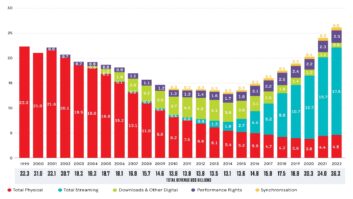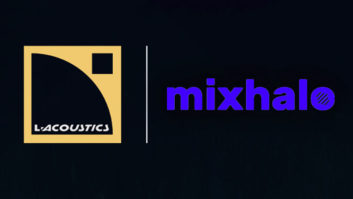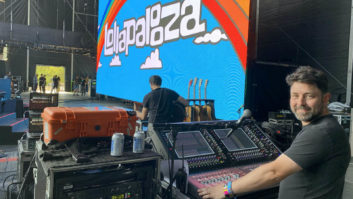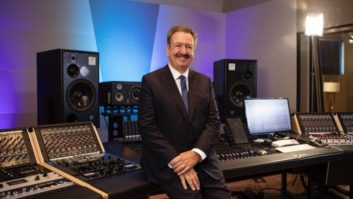Increased competition, costs put pressure on remote vehiclesThey are, perhaps, the last of the romantics in an increasingly corporate professional audio industry. Mobile and remote recording operations have proliferated in recent years, driven largely by the cheap and compact digital audio revolution. Smaller trucks and portable systems seem to be popping up everywhere, but the high end doesn’t appear to be terribly bothered by expansion of the lower end. Maybe that’s because the overall market is booming, with work coming from broadcast (something has to fill up 200-channel cable systems), a still-thriving independent record market and new-media opportunities, including music videos on DVD and concert Webcasts.
Unlike owners of stationary facilities, many high-end truck operators report that they’ve been able to maintain or slightly increase their rates-which range from $3,000 and $5,000 per day, depending upon technology and crew configuration-thanks, in large part, to increased broadcast activity.
“When you’re dealing with broadcast-and we’ve been doing more and more of that, vs. record production-the bigger companies don’t have a problem paying for quality audio or for having a dedicated audio truck in the first place,” says Dave Hewitt, owner of Remote Recording Services, Lahaska, Pa. “There’s always business issues to deal with, but at this end of the spectrum, we’re not running into a lot of budget pressures from broadcasters. They understand what it costs to do it right.”
MORE PAY, MORE COSTSAt the same time, most remote operators report that any rate increases are often eaten up by increased expenses, particularly labor costs. “My labor costs have gone up considerably in the last year,” notes Record Plant Remote owner Kooster McAllister, who now bills crew costs separately from the base rate of the truck, in essence making it part of the `a la carte menu to minimize sticker shock. “The truck comes with one A2, then you add on and pay for whatever else you need. But I don’t mark up my labor costs, either. It’s simply a pass-along.”
The reason for higher labor costs? “You can thank television for that,” Hewitt observes wryly. “Television work has increased, and that’s good for remote audio trucks. But the wages that broadcast pays in major markets is way higher than in the music recording market. There’s a whole professional class of A2 technicians that exists in broadcast, whereas in the studio you get slave labor that dreams about hitting it big as a producer someday.” Hewitt has also been billing his crew costs `a la carte in recent years.
The labor issue is national and has hit most business sectors. In the San Francisco Bay Area, perhaps the country’s hottest job market, Kat Coffey co-owns Pacific Mobile Recorders with her husband. She notes: “We constantly have a hard time finding crew. The remote recording business is not an everyday business, and it’s hard to keep someone on when you’re not working every single day. Both myself and my husband are engineers, and that’s pretty typical. That’s what keeps this pretty much a boutique sort of business, even at the upper levels.”
Other costs have increased, not the least of which is the price of a gallon of diesel fuel, which is well over $1.25 a gallon and the cost of tires, which can cost upward of $450 each. Those tires will need replacement every 60,000 miles, which is often less than a year for many trucks.
COMPETITION EVERYWHEREWhile many say that smaller remote operations don’t have much of an effect on mid-level and upper-tier business, there are definitely more of them. “I used to do more records, but now more of the new smaller trucks do a lot of the mid-market music stuff,” says Guy Charbonneau, owner of Le Mobile in Los Angeles. “They also have something of an effect on seasonal business, when television is slower and people look for cheaper service providers.”
Competition comes from above, as well, as more corporate video trucks add a small digital console, trying to get a larger piece of the field production pie. “Television thinks the DA-88 is the greatest thing in the world,” Charbonneau says with a sarcastic laugh. “Put a few in a video truck and you’ve got an audio truck.” On a more sober note, he adds, “That’s a real issue to contend with. It means we’re going to have to spend more time educating our clients in regards to what it really means to have a full-service audio provider, someone who not only has the high-end equipment but also the knowledge and the experience.”
Still, the technology of the last decade has made the remote community considerably more upwardly mobile. Lonnie Bedell, owner of Goin’ Mobile in Boston, finds most of his work in the New York metropolitan area, where he says his client base of independent and gospel recording artists and regional radio shows are more numerous and more affluent. Bedell started out a dozen years ago in a van with a 1-inch 16-track deck but quickly switched to ADATs when they became available. “That technology is what made it possible for me to stay in the business and to grow it,” Bedell states. Now with four ADATs and four DA-88s, he has upgraded from the van to a 22-foot truck, partly to provide more amenities for clients but also to project a more affluent image.
Opportunities are out there, particularly in servicing regions that don’t really have remote facilities to speak of. Transcontinental Studios debuted its remote truck, TCON-2, a year and a half ago because there were no remote facilities in the Orlando area, and the company needed something to support its boy-band empire, which includes Backstreet Boys and ‘N Sync. The result, says Transcontinental VP of studio operations Joe Smith, is a $3,500-a-day truck that has found a hole in a regional market. “The growth in the Florida area and all the new venues that are opening up here are actually a tremendous opportunity for remote recording,” he says.
NEW MEDIA, NEW VENUESTechnology advances always breed new opportunities, and in the remote recording world, that means DVD and Webcasts. Within the past year, Kooster McAllister has recorded DVD productions in 5.1 for Janet Jackson and Peter Frampton, and even more work came from Webcasts for Tom Petty, Kenny Wayne Shepherd and David Bowie. “It amazes me that people will sit and watch these jittery videos,” says McAllister. “But once they increase the bandwidth on the Internet and these concerts can compete with pay-per-views, then this is going to be a market sector that will explode. And I think it’s going to be good for everyone in the remote recording business.” Dave Hewitt sees the short-term prospects as well. “A lot of it is simply one more feed from concerts that are being broadcast anyway,” he says. “It’s another service that can be offered.”
Malcolm Harper, owner of Austin-based Reelsound Recording with 30 years in the industry, says the potential for Webcast work is huge, particularly in areas like Austin, with its hundreds of clubs and international profile as a music mecca. The main problem, he says, will be riding out the early years of low bandwidth and even lower budgets. “They just don’t have the budgets yet,” he explains. “You tell them $3,000 for the day, and they choke. Then they say, ‘Just give me a mix right off the board.’ But as the quality and use of the Internet expands, they’re all going to be taking harder looks at their audio, and they’ll find the money.”
Another issue regarding Webcasts is finding the work in a market sector that is still nascent. Bedell says his market research consists of surfing the Web in search of Webcast companies. “You can’t find them looking in the usual ways you scout for new business,” he says. “You have to look around the Web-that’s where it lives and breathes.”
But don’t forget the tried-and true. Guy Charbonneau notes that even as music recording has contracted in recent years, film scoring work has increased; he now has 25 major-studio motion picture credits under his seat belt. “That’s a market that’s actively looking for service providers with a higher level of expertise and technology, as film sound becomes a more important component in marketing movies,” he says.
The bottom line is that there are likely more positives than negatives in the long-term outlook for remote recording. Kat Coffey says: “As the average listener/viewer is becoming more sophisticated, radio and TV stations are forced to provide quality audio. We no longer mix on Auratones to hear the ‘car radio sound’ or the 3-inch TV speaker, since people now have sound systems in their cars and high-quality audio systems in their living rooms, many with surround sound capability. What this means to remote recording trucks is that there is more demand for our services even if it’s for broadcast only. Finally, broadcasters are realizing that a feed from the house board at a concert isn’t enough.







